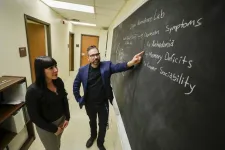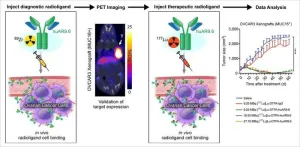(Press-News.org) Despite vaccine shortages, many younger people in New York City accessed vaccines ahead of schedule, particularly in high-income areas, according to new research at Columbia University Mailman School of Public Health. Low-income areas with high proportions of older people demonstrated lower coverage rates than wealthier areas in the first three months of vaccine rollout, and higher mortality over the year. The findings are published in the Journal of Urban Health.
“A vaccine program that prioritized those at greatest risk of COVID-19-associated morbidity and mortality would have prevented more deaths than the strategy that was implemented,” said Nina Schwalbe, adjunct professor of population and family health at Columbia Mailman School. “When rolling out a new vaccine, policymakers must account for local conditions of high-risk population groups. If New York had focused limited vaccine supply on low-income areas with high proportions of residents 65 or older, overall mortality might have been lower.”
The researchers describe the rollout plan and the timetable for the various groups and when they received their vaccinations. Beginning on December 14, 2020 New York administered its first vaccines to high-risk hospital workers, leading to all adults 70 years and older (on January 4, 2021), 60 and older (10 March 2021); 50 and older (23 March) and all adults 30 years and older (on March 30 2021). During this period, the New York State Department of Health in collaboration with the New York City Department of Health and Mental Hygiene delivered vaccines primarily through fixed-point mass vaccination sites.
The researchers analyzed linked Census Bureau data and New York City Health administrative data aggregated at the level of modified zip code tabulation areas (MODZCTA). Race, income, and age data by MODZCTA were obtained from the US Census Bureau. Calculations were based on COVID-19 mortality rates per 100,000 population in each MODZCTA from December 1, 2020 to December 31, 2021.
“In New York, as elsewhere, the probability of dying from COVID-19 was not equally distributed across the population. The single greatest risk factor for COVID-19-related mortality was older age; low-income households were also particularly vulnerable,” noted Schwalbe.
By the last week of March, the mean vaccination rate for 65+ ranged from 53 percent in the poorest quintile to 75 percent in the wealthiest. The maximum coverage was 99 percent among those 65+ in the wealthiest area versus 68 percent in the poorest. One year later when vaccines were widely available, 65+ residents had median vaccination coverage exceeding 87 percent, including in the lowest wealth area.
“Our analysis explores whether New York widened vaccination eligibility too quickly in the face of vaccine shortages rather than focusing first on those at higher risk, begging the question of whether older New Yorkers living in low-income communities would have been better served in the face of COVID-19 vaccine shortages if distribution had been targeted toward them,” noted Schwalbe.
At a time when vaccine supply was still limited, many lower-risk, younger people accessed vaccines ahead of schedule, particularly in high-income suggesting “misallocation” of doses that could have been provided to older people, who had higher case fatality rates, according to Schwalbe and colleagues, which could have been corrected by authorities through more stringent enforcement of state mandated guidelines on distribution criteria. “While it is plausible that access for younger people was granted to those in scheduled professions or having underlying health risks, this is unlikely to account for the magnitude of difference between low and high-income zip codes,” noted Schwalbe.
“Our analysis provides clear evidence of why U.S. policymakers must target their distribution approach to providing access to lifesaving technologies in short supply, focusing first on those most at risk of severe morbidity and mortality.”
Co-authors are Marta C Nunes, Medical Research Council, University of the Witwatersrand, Johannesburg, and Center of Excellence in Respiratory Pathogens, Hospices Civils de Lyon, and Centre International de Recherche en Infectiologie, Université Claude Bernard Lyon 1, Inserm; Clare Cutland, University of the Witwatersrand; and Brian Wahl, Johns Hopkins Bloomberg School of Public Health; and Daniel Reidpath, Queen Margaret University, Edinburgh and Monash University.
Columbia University Mailman School of Public Health
Founded in 1922, the Columbia University Mailman School of Public Health pursues an agenda of research, education, and service to address the critical and complex public health issues affecting New Yorkers, the nation and the world. The Columbia Mailman School is the fourth largest recipient of NIH grants among schools of public health. Its nearly 300 multi-disciplinary faculty members work in more than 100 countries around the world, addressing such issues as preventing infectious and chronic diseases, environmental health, maternal and child health, health policy, climate change and health, and public health preparedness. It is a leader in public health education with more than 1,300 graduate students from 55 nations pursuing a variety of master’s and doctoral degree programs. The Columbia Mailman School is also home to numerous world-renowned research centers, including ICAP and the Center for Infection and Immunity. For more information, please visit www.mailman.columbia.edu.
END
Study finds many younger people from high income neighborhoods jumped the eligibility queue for COVID-19 vaccines in NYC
More deaths could have been averted if vaccine roll out had been more stringently focused on older people in low income neighborhoods
2024-04-05
ELSE PRESS RELEASES FROM THIS DATE:
Rapid, simultaneous detection of multiple bacteria achieved with handheld sensor
2024-04-05
Hear the words E. coli or salmonella and food poisoning comes to mind. Rapid detection of such bacteria is crucial in preventing outbreaks of foodborne illness. While the usual practice is to take food samples to a laboratory to see the type and quantity of bacteria that forms in a petri dish over a span of days, an Osaka Metropolitan University research team has created a handheld device for quick on-site detection.
Led by Professor Hiroshi Shiigi of the Graduate School of Engineering, the team experimented with a biosensor that can simultaneously detect multiple disease-causing bacterial species within an hour.
“The palm-sized device for detection ...
Suicides among US college student athletes have doubled over past 20 years
2024-04-05
The number of suicides among US college student athletes has doubled over the past 20 years, finds an analysis of data from the National Collegiate Athletic Association (NCAA), published online in the British Journal of Sports Medicine.
Suicide is now the second most common cause of death after accidents in this group of young people, with rates highest among cross-country competitors, the findings show.
US suicide rates rose by around 36% across all age groups between 2001 and 2021, note the researchers. But the evidence ...
The Lancet: Prostate cancer cases expected to double worldwide between 2020 and 2040, new analysis suggests
2024-04-05
The Lancet: Prostate cancer cases expected to double worldwide between 2020 and 2040, new analysis suggests
Annual prostate cancer cases are projected to rise from 1.4 million in 2020 to 2.9 million in 2040, and annual deaths to increase by 85% to almost 700,000 over the same timeframe, mainly among men in low-and middle-income countries (LMICs).
The Lancet Commission on prostate cancer argues that the ‘informed choice’ programme for prostate cancer screening with PSA testing, which is common in high-income countries ...
Britain began industrializing in the 17th century – over a 100 years earlier than history books claim
2024-04-05
Britain was already well on its way to an industrialised economy under the reign of the Stuarts in the 17th century – over 100 years before textbooks mark the start of the Industrial Revolution – according to the most detailed occupational history of a nation ever constructed.
Built from more than 160 million records and spanning over three centuries, the University of Cambridge’s Economies Past website uses census data, parish registers, probate records and more to track changes to the British labour force from the Elizabethan era to the eve of World War One.
The research shows that 17th century Britain saw a steep decline ...
Bladder cancer treatment can be better targeted and more effective, trials show
2024-04-05
Testing for tumour DNA in the blood can successfully identify advanced bladder cancer patients who will not relapse following surgery, new research shows.
This could allow doctors to target treatments more effectively to those who need it, and spare those patients for whom further treatment is unnecessary, researchers say.
The findings from the screening phase of the IMvigor011 Phase III trial are presented today [Friday 5 April] at the European Association of Urology Congress in Paris.
They show that just over 90% of muscle invasive bladder cancer (MIBC) patients with a ...
Ocean floor a 'reservoir' of plastic pollution, world-first study finds
2024-04-05
New research from CSIRO, Australia’s national science agency, and the University of Toronto in Canada, estimates up to 11 million tonnes of plastic pollution is sitting on the ocean floor.
Every minute, a garbage truck’s worth of plastic enters the ocean. With plastic use expected to double by 2040, understanding how and where it travels is crucial to protecting marine ecosystems and wildlife.
Dr Denise Hardesty, Senior Research Scientist with CSIRO, said this is the first estimate of how much plastic waste ends up on the ocean floor, where it accumulates before being ...
Scientists discover potential treatment approaches for polycystic kidney disease
2024-04-04
Researchers have shown that dangerous cysts, which form over time in polycystic kidney disease (PKD), can be prevented by a single normal copy of a defective gene. This means the potential exists that scientists could one day tailor a gene therapy to treat the disease. They also discovered that a type of drug, known as a glycoside, can sidestep the effects of the defective gene in PKD. The discoveries could set the stage for new therapeutic approaches to treating PKD, which affects millions worldwide. The study, partially funded by the National Institutes of Health (NIH), is published in Cell Stem Cell.
Scientists ...
UTEP study: prairie voles display signs of human-like depression
2024-04-04
EL PASO, Texas (April 4, 2024) – Psychology researchers at The University of Texas at El Paso are making progress towards understanding the biological underpinnings of depression, a leading cause of disability that affects approximately 280 million people around the world.
In a study published this April in the Journal of Affective Disorders, UTEP psychologist Sergio Iñiguez, Ph.D., and his co-authors make the case that prairie voles, small rodents that are found throughout the central United States and Canada, can be effectively used as animal models to further the study of ...
Researchers envision sci-fi worlds involving changes to atmospheric water cycle
2024-04-04
Human activity is changing the way water flows between the Earth and atmosphere in complex ways and with likely long-lasting consequences that are hard to picture.
Land use change is altering where clouds form and how precipitation is distributed. Meanwhile, weather modification activities like cloud seeding are shifting how nations plan for water use in the face of climate change. These and other changes to the planet’s atmospheric water cycle were once hard to imagine but are increasingly part of modern water management on the planet.
Colorado State University Assistant Professor Patrick Keys is an expert ...
Novel theranostic tool allows for noninvasive identification and treatment of ovarian cancer
2024-04-04
Reston, VA—A new radiotheranostic system has the ability to detect and treat ovarian cancer noninvasively, according to new research published in the April issue of The Journal of Nuclear Medicine. Combining the highly specific huAR9.6 antibody with PET and therapeutic radionuclides, this theranostic platform may provide more personalized treatment to improve health outcomes for ovarian cancer patients.
Ovarian cancer causes more deaths than any other gynecologic malignancy, with a five-year survival rate below 30 percent for patients diagnosed at advanced stages. The current standard of care for ovarian cancer consists of surgery followed by platinum-based chemotherapy; however, ...
LAST 30 PRESS RELEASES:
Injectable breast ‘implant’ offers alternative to traditional surgeries
Neuroscientists devise formulas to measure multilingualism
New prostate cancer trial seeks to reduce toxicity without sacrificing efficacy
Geometry shapes life
A CRISPR screen reveals many previously unrecognized genes required for brain development and a new neurodevelopmental disorder
Hot flush treatment has anti-breast cancer activity, study finds
Securing AI systems against growing cybersecurity threats
Longest observation of an active solar region
Why nail-biting, procrastination and other self-sabotaging behaviors are rooted in survival instincts
Regional variations in mechanical properties of porcine leptomeninges
Artificial empathy in therapy and healthcare: advancements in interpersonal interaction technologies
Why some brains switch gears more efficiently than others
UVA’s Jundong Li wins ICDM’S 2025 Tao Li Award for data mining, machine learning
UVA’s low-power, high-performance computer power player Mircea Stan earns National Academy of Inventors fellowship
Not playing by the rules: USU researcher explores filamentous algae dynamics in rivers
Do our body clocks influence our risk of dementia?
Anthropologists offer new evidence of bipedalism in long-debated fossil discovery
Safer receipt paper from wood
Dosage-sensitive genes suggest no whole-genome duplications in ancestral angiosperm
First ancient human herpesvirus genomes document their deep history with humans
Why Some Bacteria Survive Antibiotics and How to Stop Them - New study reveals that bacteria can survive antibiotic treatment through two fundamentally different “shutdown modes”
UCLA study links scar healing to dangerous placenta condition
CHANGE-seq-BE finds off-target changes in the genome from base editors
The Journal of Nuclear Medicine Ahead-of-Print Tip Sheet: January 2, 2026
Delayed or absent first dose of measles, mumps, and rubella vaccination
Trends in US preterm birth rates by household income and race and ethnicity
Study identifies potential biomarker linked to progression and brain inflammation in multiple sclerosis
Many mothers in Norway do not show up for postnatal check-ups
Researchers want to find out why quick clay is so unstable
Superradiant spins show teamwork at the quantum scale
[Press-News.org] Study finds many younger people from high income neighborhoods jumped the eligibility queue for COVID-19 vaccines in NYCMore deaths could have been averted if vaccine roll out had been more stringently focused on older people in low income neighborhoods





